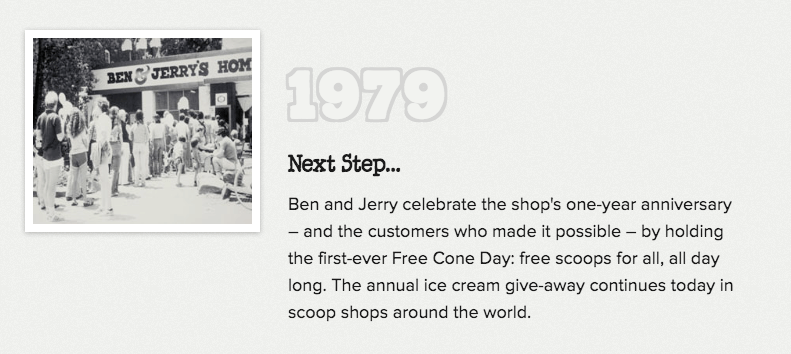Free as in no cost?
Free as in freedom?
Free as in no value?
The word “free” can elicit many different emotions. And we all know emotions play a huge role in marketing. So, is using the word “free” in your marketing campaigns dangerous? Or can it be genius?
Let’s Look at Some Examples
Take this image:

It’s actually refreshing and inspiring to look at. If I were marketing a mediation class, this is exactly how I would use the word free.
And then there’s..
It’s finally here! Free Cone Day is TODAY! Find your local Ben & Jerry's Scoop Shop: https://t.co/BOrk2Px8yj pic.twitter.com/YdA4jvFRsy
— Ben & Jerry's (@benandjerrys) April 4, 2017
Which may very well lead to the biggest event of the year for Ben and Jerry’s and be a major driver of increased customer lifetime value. If every person that comes by to get that free cone remembers how good their ice cream tastes and ends up buying two pints of Ben and Jerry’s that year, well then, the event was certainly a success.
But Let’s Dissect This Campaign Further

There is a something a bit deeper about this Ben & Jerry’s event. It doesn’t just get people to buy more ice cream down the road. It brings families and friends together.
Once Ben & Jerry’s customers get their cone and start enjoying it with their companions, it becomes a moment that their circle will probably never forget. Therefore, the brand touch is very positive in this respect, bringing families and friends together, making tongues happy, etc.
The genius here is that the brand gets linked to all those positive emotions. As you can see, the people behind this campaign know it provides way more value to the company than just a couple extra ice cream sales down the road. It’s really about building loyal customers through pinging positive emotions.
In this case, Ben & Jerry’s is not working from an angle where the initial thought is, “Let’s try giving something away for free.” Instead, they work backwards. They start with the thought, “What’s a big way to thank our customers, bring them together and make them happy?” This campaign exercise eventually determined that a free cone day is the answer to that question.

From Ben & Jerry’s About Us Page
If I had to take a wild guess, I would say that Free Cone Day ties back to one of Ben & Jerry’s core brand values. Brand values are key to guiding any company through marketing campaigns, strategic planning and tough company decisions. Make sure you nail yours down.
Finally, from a buzz and SEO perspective, this type of event works wonders. Not only do they get a gazillion retweets and shares. The story becomes social currency as it travels through the Internet and news outlets. From an SEO perspective, that’s the Holy Grail. This is how the best organic backlinks are created.
It’s All About How You Use the Word “Free”
As you can see in the case of Ben & Jerry’s – free can be extremely powerful. That free ice cream campaign probably moved hundreds of thousands of Americans to a local retail Ben & Jerry’s outlet. What they don’t want you to know is that it probably put a few thousand metric tons of CO2 in the air as well 😬.
And when we talk about how you use the word free, you first have to consider how your audience views your brand.
Are you a new company and no one knows about you? Then using the word “free” can have much less of an impact. A large brand like Ben and Jerry’s is well known and trusted. No one expects to show up to one of their ice cream shops thinking that there is a chance they’re being duped.
On the other hand, if Ben and Jerry’s makes a mistake in how they coordinate a free cone event, then it could do major damage to their brand.
WITH GREAT POWER THERE MUST ALSO COME — GREAT RESPONSIBILITY. – Stan Lee
Free and the Dangerous Association to Little Value
If you’re smaller and you start giving away “stuff” for free all the time, you could be sabotaging your brand image. People may start getting the idea that your brand provides little value if you’re constantly dishing out free offers. This is when free can cheapen your brand, so use it very carefully (and maybe not that often at all).
In other cases, your audience may get conditioned to wait for your free offers before purchasing or doing business with you. This happens to companies that overdo it with coupon marketing. Some companies get trapped in a vicious cycle where they have to run endless coupon campaigns just to keep business coming through the door. You really want to avoid that situation at all costs.
Remember, Apple Computer never promotes coupons and always charges a steep price for their products. The psychology here works in the other direction, making Apple one of the highest revenue generating companies of all time.
What probably happens more often than not, is that marketing teams jump the gun with a discounting campaign without really thinking through the repercussions. So, before you decide to go on a discounting rampage or get overly excited about launching a “free _______” campaign, ask yourself these questions:
- What do discounts and coupons do to our brand image? Does it affect our brand in a negative or positive way?
- Does discounting increase customer lifetime value? Do we have a way to measure this?
- Should we experiment with discounting and only offer it to a test segment before we offer it to a wider group of people?
Freedom and Being Free
This is a less risky use of free. In the United States, freedom is an important characteristic of our culture. We’re a nation of people who can hop in a car and travel thousands of miles in any direction, and be whisked away in an instant adventure. We really like the idea of endless opportunities and dreaming big. And we sure as heck don’t like people telling us what to do.
When you consider the emotional impact of this kind of free, you’re really tapping into a core value of the U.S. demographic. So, just keep that in mind when you’re thinking of your next marketing campaign. It may fit, it may not.
This campaign by WOW air is a brilliant use of “freedom marketing”:
WOW air and their marketing team obviously knows the U.S. adventure seeker demographic very well. All they needed was a surfer and a camera crew. Luckily, for WOW air, flights are pretty easy to arrange 🙂 .
Finally, Offering Something Free Other Than Your Main Product or Service
This could be giveaways, free content, samples, consultation, etc.
One of my favorite stories that’s related to this tactic goes back to the 1800s. In dry counties throughout the United States (where selling alcohol was illegal), a common loophole was to offer customers free liquor when a meal was purchased.
But even with clever tactics, you want to be careful of how the offer reflects your brand. Plastering the word “free” everywhere is still something you’ll want to stay away from. There’s nothing wrong with offering something free to begin a customer relationship. You just want to keep it tactful, and most importantly, aligned with your brand values and overall company strategy.


I think it’s all about giving honest value to the customer. If something cannot be free because it’s economically unlikely, it’s a scam. Free credit reports are actually OK because one per year is free by government mandate.
And apple could offer free tutorials when signing up for a newsletter.
I think the biggest mistake is to offer something free that has no value. That’s insulting.
Like a free slap in the face.
Hahaha…